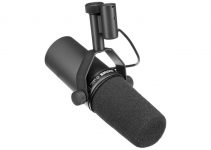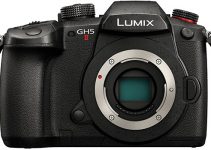The term itself of a full-frame sensor is somehow misleading IMHO. It implies that other sizes are not, in fact, full. This may seem the rant of an old-timer, but bear with me and you’ll see that there’s some truth to that. What was an advertising stunt from the photographic world, in time was accepted as normal lingo for all the filmmakers that approached the video production universe after the so-called DSLR revolution.
Before that, DPs simply spoke a different language: 16mm, Super 16, Super 35 were all common terms, and in the digital age we got 1/3″ CCDs and similar CMOS sensors. What happened is that at the beginning of digital photography no one could make a sensor of the same size as the photographic 35mm film, a format never used in video. So when manufacturers finally got to that size, it was advertised as the “full-frame sensor“, and the great misunderstanding began.
Needing to explain the FOV of the lens to most folks who had used lenses on 35mm sensors, the concept of crop factor was introduced and the misunderstanding got even worse. Now, Gerald Undone will try to shed a light on the use of focal reducers, macro lenses, and smaller, or “cropped” sensors in an attempt to put things into perspective once and for all.
The idea covered in the video is quite clever. Using a ruler and a macro lens, Gerald explains the crop factor with simple graphics, making it easy to understand also to those who are not very familiar with the concepts involved. Let’s start with some definitions, like macro lens.
In a nutshell, a macro lens is a lens capable of reproducing an object at its real size on the sensor, in a 1:1 ratio. That means that a macro lens on a 35mm sensor recording a ruler in front of it will capture 35mm of the ruler, being that the 1:1 ratio. And, in fact, that’s exactly what happens.
This is where things start to get interesting. The image we are considering in the above example is captured with 16:9 ratio, not 3:2. That is actually the ratio of still photography and that means that we can cut a bit of the sensor, considering an area of 22,25 x 36mm.
In the image below, we can see the area highlighted in yellow on the right, and that is the 16:9 sensor, while on the left, there’s the recorded image itself.
Now, let’s suppose we’re dealing with a smaller sensor like the one on the Pocket 6K. We will have a smaller sensible area on the right and a respective smaller projection of the ruler. If you think about it, that means that the image is not zoomed in. What is happening is that we are taking a smaller portion of the same image.
We can check the number of mm from the ruler in the frame and we’ll see that the ratio is still 1:1 since we’re getting 22mm, the size of the Pocket 6K sensor. There is no magnification going on here, we’re just looking at a smaller piece of the same ruler. The same applies if we switch to the Pocket 4K – we would have an even smaller portion of 18,99mm, the size of the Pocket 4K sensor itself.
Now, let’s get to the headache part. If you’re not familiar with math, buckle up, you’re in for a ride. Usually, when we read about crop sensors, we are offered a crop factor, something like 1.56x or 1.9x (that are the crop factors of the Pocket 6K and 4K). Where does that number come from? Well, it’s one of two ways.
You can either compare the width of the two sensors, or the diagonal of the two. In both cases you’ll get a similar number, a small difference may derive from rounding some decimal while calculating the diagonal. You can see the spreadsheet Gerald used to do the math, but trust us, it’s much simpler than it seems.
Part of the controversy you may find online in forums and so on is due to a small error in this phase. In fact, if you confront the diagonals but you use the full-frame sensor and you don’t account for the different ratio (16:9 instead of 3:2), you’ll have different results.
Once you factor in the image ratio, you’ll get the same numbers. That goes the same way for the Pocket 4K, where you have to reduce even more the height since the ratio is even smaller.
Long story short, the math goes both ways. If you have the size of the full-frame, that we know is 36mm, and divide it by the crop factor, you get that on the Pocket 6K. In other words, you should expect to see a 23.1mm portion of the ruler. And, voilà, that’s exactly the case. So, once that is clear, we can throw the Speed Booster adapters into the mix. How is that going to affect these proportions?
Let’s think about it. The Speed Booster is going to focus the image circle in a narrower space, thus compressing the image by 30%. Going back to the graphics, we can see that the image circle is too small for the full-frame, but it covers perfectly the Pocket 4K that now gets more “ruler space” on it, more or less 25 or 26mm.
The shot made with a 100mm macro lens confirms that statement and shows us a frame that goes up to 26mm of the ruler. By doing a simple calculation, we can get our final “boosted” crop factor, that is 1,35x on the Pocket 4K sensor.
Yeah, I know, if you’re not a math-guy you may feel a little bit dizzy, but if you go through the process once again, I’m sure it’ll make more sense. Take your time, since grasping these basic concepts can be of great use when you have to choose a lens on the fly, or while location scouting and you end up shooting with a different camera and sensor size.
It may sound silly, but you never know when you’ll need to know how to do the math using either method. Simply choose what you prefer, but math stays true to itself, therefore it will always give you the correct answer.
[source: Gerald Undone]
Disclaimer: As an Amazon Associate partner and participant in B&H and Adorama Affiliate programmes, we earn a small comission from each purchase made through the affiliate links listed above at no additional cost to you.




